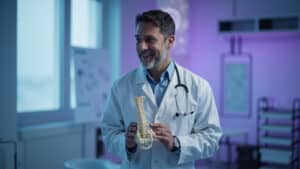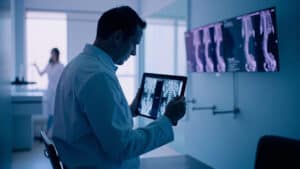Can Degenerative Disc Disease Be Prevented? Revolutionary Ways to Safeguard Your Mobility
Written by Dr. Matthias Wiederholz, MD, Board Certified in Physical Medicine & Rehabilitation, Pain Medicine, Sports Medicine, and Anti-Aging, Regenerative & Functional Medicine
Quick Insights
Can degenerative disc disease be prevented? Degenerative disc disease (DDD) is the gradual breakdown of spinal discs over time, leading to back pain and reduced mobility. While aging is inevitable, research shows that adopting healthy habits—like exercise and weight management—can reduce your risks and help you preserve lifelong spine health according to leading medical evidence.
Explore minimally invasive Discseel® regenerative solutions to restore spine health and delay degeneration.
Key Takeaways
- Modifiable risk factors such as smoking, obesity, and diabetes increase the likelihood of spinal disc degeneration.
- Regular, multi-component exercise programs are proven to help prevent DDD-related back pain and mobility loss.
- Rehabilitation strategies tailored to individual needs can protect spinal discs and support prevention.
- Emerging biologic therapies like Discseel® are being explored as potential treatments for spinal disc conditions; however, further research is needed to confirm their effectiveness in delaying or halting degeneration.
Why It Matters
Understanding if degenerative disc disease can be prevented empowers you to take charge of your spinal health. Making proactive choices today enhances your mobility, protects independence, and helps you keep doing what you love—whether that’s sports, family time, or daily routines—without anxiety about long-term pain or surgery. Dr. Matthias Wiederholz, MD, offers comprehensive evaluations and advanced care for spinal health.
As a quadruple board-certified interventional pain and regenerative medicine specialist, I bring extensive expertise to the question: Can degenerative disc disease be prevented?
Degenerative disc disease (breakdown of spinal discs over time) is a leading cause of back pain, often limiting daily activities and independence. For patients in Houston, TX, understanding what degenerative disc disease is—and how to prevent spinal disc degeneration—can make the difference between years of discomfort and a future of mobility.
While some disc changes are a natural part of aging, research shows that adopting targeted lifestyle changes and early intervention can help protect your spine for the long term. Low back pain is now recognized as the leading cause of disability worldwide, with prevention strategies offering real hope for maintaining an active lifestyle.
If you want to stay active and avoid invasive surgery, you’re in the right place—let’s explore what truly works to keep your spine healthy. Learn more about Back Pain treatment options.
What is Degenerative Disc Disease?
Degenerative disc disease (DDD) refers to the gradual breakdown of the intervertebral discs—the soft, cushion-like structures separating your spinal bones (vertebrae). These discs act as shock absorbers, supporting your spine’s flexibility and movement. Over many years, discs can lose hydration and elasticity, leading to small cracks or tears in the annulus fibrosis (the tough outer shell) and changes in the nucleus pulposus (the gel-like core inside each disc).
This process can generate inflammation and pain—sometimes even when the changes are invisible on early imaging. See Disc Desiccation: Understanding the Causes, Symptoms, and Treatment for more on what happens when these discs dry out.
How DDD Develops
DDD develops primarily as discs lose water content and become less elastic with age, but it can be accelerated by injuries, genetics, and lifestyle factors. As a quadruple board-certified regenerative spine specialist, I see in my daily practice that repetitive strain, sedentary habits, poor posture, and even previous trauma can set the stage for early disc degeneration.
For example, many patients spend years performing lifting, bending, or desk work with little spine support—gradually weakening discs long before symptoms become obvious. According to a recent systematic review, early identification and proactive risk management can make a profound difference in slowing progression and improving outcomes for those at risk of DDD. Recent research highlights the importance of early intervention and risk monitoring.
Clinical Observation Statement:
In my practice, I frequently encounter patients who have spent years exploring treatments—from surgeries to pain medications—without achieving meaningful relief. Often, they are unaware that minimally invasive regenerative solutions like Discseel® can effectively restore their spine health.
Learn about Effective Treatment Options for L5-S1 Disc Herniation Pain if you’re already experiencing symptoms.
Common Symptoms
Common symptoms of DDD include:
- Persistent low back or neck pain
- Stiffness or loss of spinal flexibility
- Pain that worsens with sitting, bending, or lifting
Some people may experience numbness, tingling, or muscle weakness if nerves become compressed.
Experience-Based Insight:
Having personally performed over 10,000 regenerative spine procedures, I’ve consistently witnessed that early recognition of these symptoms allows for non-surgical intervention—often sparing patients from unnecessary disability and chronic pain. Read Symptoms of Bulging Disc in Neck C5-C6 for symptoms specific to the neck.
Can Degenerative Disc Disease Be Prevented?
Degenerative disc disease cannot be stopped entirely, but you can substantially reduce your risk and slow its progression by making specific lifestyle changes and taking proactive steps.
Key Prevention Strategies Include:
- Consistent, targeted exercise (especially core strength and flexibility)
- Weight management
- Smoking cessation
- Control of chronic health conditions (like diabetes)
Professional Assessment Phrase:
As a quadruple board-certified regenerative medicine specialist, I’ve observed that the sooner we match a patient’s risk profile with proven prevention strategies, the better we can protect their long-term spine health.
High-level evidence confirms that individualized prevention and early lifestyle modifications can be highly effective for reducing risk and preserving spinal function. Evidence supports the value of prevention and management systems.
See L5-S1 Herniated Disc Surgery: Overview for an overview of surgical options if prevention is no longer enough.
Major Risk Factors for Degenerative Disc Disease
Recognizing your risk factors is essential for early prevention. Some risks are within your control—others, like aging or genetics, are not, but you can still minimize their impact through smart habits.
Modifiable Risk Factors
- Smoking: Decreases blood flow to discs, speeding up degeneration.
- Obesity: Adds mechanical stress to the spine.
- Diabetes: Impairs disc nutrition and healing.
- Physical inactivity: Weak core and poor support increase disc vulnerability.
Clinical Observation Statement:
I often counsel patients that addressing these modifiable risks not only helps their spine but boosts their overall wellness as well.
Research demonstrates that managing these factors leads to better outcomes and fewer complications from DDD. Modifiable risk factors play a significant role in DDD progression. Learn how to stay proactive with Herniated Disc Exercises.
Non-Modifiable Risk Factors
- Age: Disc degeneration becomes more common with advancing years.
- Genetics: A strong family history raises risk.
- Prior spinal injuries: Trauma can expedite disc changes.
Reputable clinical guidelines now recommend tailoring prevention plans to each patient’s unique risk profile for best results. Personalized strategies are essential for effective prevention.
Explore Degenerative Disc Disease Treatment Options for more on current approaches.
When to Seek Medical Attention
If you suddenly experience severe back pain, difficulty controlling bladder/bowel function, or progressive limb weakness, seek medical attention immediately—these signs can indicate a serious, rapidly evolving spinal condition. Emergency Symptoms of a Herniated Disc can help you recognize critical warning flags.
Proven Prevention Strategies
Preventing DDD begins with simple, everyday choices that can powerfully shape your future mobility. My core advice: focus on what’s within your control—starting with movement, weight, and healthy living.
Exercise-Based Prevention
Dynamic, multi-component exercise programs are among the most effective ways to prevent and manage DDD-related pain. Best practices include:
- Regular core strengthening
- Flexibility and stretching routines (such as yoga or gentle Pilates)
- Low-impact aerobic activity (walking, swimming, cycling)
A recent systematic review found supervised, individualized exercise programs not only minimize pain and stiffness but help keep patients off the sidelines—no matter their age or starting point. Exercise-based rehabilitation is essential for prevention and management.
Experience-Based Insight:
I’ve personally seen that patients who commit to exercise they enjoy and can maintain are the ones who reclaim and preserve their quality of life the longest.
Professional Assessment Phrase:
Matching exercise routines to a patient’s activity level, disc status, and goals—whether you’re a golfer, runner, or grandparent—dramatically boosts results and confidence.
Read about Understanding S1 Nerve Distribution: Anatomy, Symptoms, and Treatment for those experiencing radiating symptoms.
Lifestyle Modifications
- Maintain a healthy weight: Lighter loads mean less disc wear.
- Avoid smoking: smoking decreases oxygen and nutrition to spinal discs.
- Control chronic conditions: Keep diabetes and hypertension at bay.
- Optimize posture: Support your spine at work, during sleep, and during daily activities.
Technological advances—like AI-based decision support—are now helping more people meet their prevention goals and stick with evidence-based plans. AI tools are improving compliance with preventive strategies.
Comparative Expertise:
Unlike larger clinics where patients often see a different provider for each visit, I personally guide every patient through spine-saving lifestyle changes, from movement coaching to ergonomic workspace adjustments.
Check out Managing Lumbar Degenerative Disc Disease for additional lifestyle guidance.
Revolutionary Regenerative Solutions: Spotlight on Discseel®
As one of only three certified master instructors for Discseel® worldwide, directly trained by its inventor, I’m proud to offer Houston-area patients a minimally invasive biologic approach to disc degeneration.
Discseel® uses a natural fibrin sealant to repair annular tears (tiny cracks in the disc wall) and promote the body’s own collagen regeneration—addressing the foundation, not just the symptoms, of disc pain. For a comprehensive patient perspective, visit Discseel® Reviews: Achieving Lasting Back Pain Relief. Learn more from the official Discseel® website.
How Discseel® Compares to Traditional Treatments
Traditional procedures like spinal fusion often involve hardware, remove natural motion, and require a lengthy recovery. In contrast, Discseel® preserves the body’s native disc structure and can start the healing process within days—no major incisions required. In suitable patients, I’ve seen Discseel® transform lives, even for those who had been told surgery or spinal fusion was their only option. Regenerative medicine is transforming the outlook for DDD.
Experience-Based Insight:
Having performed thousands of Discseel® and regenerative spine procedures, I’ve witnessed firsthand how restoring disc integrity—rather than replacing or fusing it—empowers patients to reclaim their activities with newfound hope.
Patient Candidacy for Discseel®
Discseel® is an option for patients with:
- Degenerative disc disease
- Annular tears (microscopic or large)
- Herniated discs
- Failed previous back surgery
See Disc Tear Treatment: Restoring the Integrity of Your Spine for more on disc tears.
If you have been told surgery is your only path, or want to avoid spinal fusion while preserving your mobility, Discseel® may be right for you. I personally oversee every part of your evaluation and recovery to ensure the plan fits your needs and goals.
Why Trust Your Spine to Dr. Matthias Wiederholz in Houston, TX?
Elite Credentials & Experience
I am proud to be quadruple board-certified and a master instructor in Discseel®—credentials held by only a handful of providers nationally. My residency at Baylor College and direct training from Discseel®’s inventor, Dr. Kevin Pauza, set our practice apart with cutting-edge, patient-first solutions. Beyond titles, I value building real relationships and delivering care that’s as empathetic as it is advanced.
Find out more about Dr. Matthias Wiederholz’s expertise.
Comparative Expertise:
Unlike high-volume spine centers, I personally perform all advanced diagnostics, Discseel® procedures, and rehabilitation guidance—so you’re never just a number on a chart.
Houston Community Focus
At Performance Pain & Sports Medicine, you’ll find boutique, responsive care—right here in Houston. We know your time matters, so our team streamlines every step, from initial consult to follow-up, for a faster return to work, hobbies, and daily life.
⭐ Patient Success Spotlight
— Rick, Houston, TX
Read more patient stories ›
What Our Patients Say on Google
Patient experiences are at the heart of my approach to spine care. Hearing directly from those I’ve treated provides valuable insight into the real-world impact of evidence-based, minimally invasive solutions.
I recently received feedback that captures what we aim to provide for every patient—personalized care, clear communication, and meaningful relief. This reviewer shared:
“I recently underwent treatment with Dr. Wiederholz, and I cannot speak highly enough about the care I received. After an auto accident, I was experiencing severe back pain, and Dr. Wiederholz recommended and administered four spinal injections that provided significant relief. Dr. Wiederholz was a resident of Baylor College of Medicine and it shows in his quality of care.” — Rick
This feedback illustrates our approach to patient care—combining advanced training with a commitment to each individual’s recovery. It’s a privilege to help Houston patients regain comfort and return to the activities they love.
Degenerative Disc Disease Prevention in Houston, TX
Living in Houston, TX, means facing unique lifestyle and environmental factors that can influence spinal health. Our city’s active culture, diverse workforce, and sometimes demanding commutes can all play a role in the development and prevention of degenerative disc disease.
Many Houstonians spend long hours sitting in traffic or at a desk, which can increase strain on the spine if posture and movement aren’t prioritized. At Performance Pain & Sports Medicine, I work closely with patients to develop prevention strategies that fit Houston’s fast-paced lifestyle—whether that means ergonomic adjustments for office workers or tailored exercise plans for those enjoying the city’s parks and golf courses.
Access to advanced regenerative treatments like Discseel® is another advantage for Houston residents seeking to avoid surgery and maintain mobility. If you’re in Houston and want to protect your spine for the long term, contact us to schedule a personalized assessment and discover the best way to prevent spinal disc degeneration right here in our community.
Conclusion
To summarize, can degenerative disc disease be prevented? While aging is inevitable, you can take meaningful steps to protect your spine and maintain your active lifestyle. By focusing on regular movement, healthy weight, and early intervention, you reduce your risk of chronic pain and loss of mobility. When disc degeneration does occur, advanced regenerative care—without invasive surgery—like Discseel® can help you reclaim the activities you love. Recent research highlights the promise of regenerative therapies for long-term relief and function.
As a quadruple board-certified regenerative spine specialist, I am dedicated to helping Houston patients achieve lasting pain relief and independence. If you’re ready to stop missing out on life due to back pain, see if you are a candidate for the Discseel® Procedure or contact Performance Pain & Sports Medicine for expert spine care.
This article is for educational purposes only and should not be used as a substitute for professional medical advice, diagnosis, or treatment. Always seek the advice of your physician or other qualified healthcare provider with any questions you may have regarding a medical condition or treatment options. Never disregard professional medical advice or delay in seeking it because of something you have read in this article.
Frequently Asked Questions
Can degenerative disc disease be prevented completely?
Degenerative disc disease cannot be stopped entirely, but you can slow its progression and reduce your risk by staying active, maintaining a healthy weight, and avoiding smoking. Individualized exercise and lifestyle changes have been shown to help preserve spinal health and minimize pain over time. Read the Comprehensive Guide to L5-S1 Bulging Disc for more on prevention.
Where can I find advanced, non-surgical spine care in Houston, TX?
You can find advanced, non-surgical spine care—including the Discseel® Procedure—at my practice, Performance Pain & Sports Medicine in Houston, TX. I offer personalized assessments and regenerative treatments designed to help you avoid surgery and return to your favorite activities as quickly as possible.
What is the best way to prevent spinal disc problems for active individuals?
The best way to prevent spinal disc problems is to engage in regular, multi-component exercise that strengthens your core and improves flexibility. Combining this with healthy weight management and good posture can significantly lower your risk. I tailor prevention plans to each patient’s activity level and goals for optimal results. Discover more about managing L4-L5 pain and symptoms.
“`

















